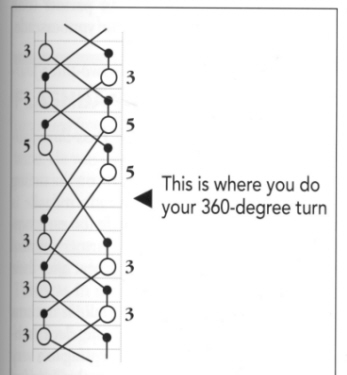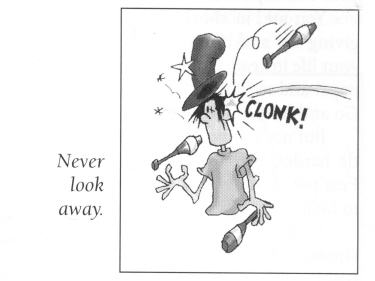Flash
Pirouette
Juggle
three clubs, toss all of them high into the air and turn once with
the grace of a ballet dancer before catching the lot - you have just
turned a Flash Pirouette.
More
likely you have just dropped everything, made yourself dizzy and
cricked your neck into the bargain! The Flash Pirouette is a
trick that truly deserves the applause when it's pulled off.
Here's
how throwing three Triples (5's) from
a Three Club Cascade leaves you
with both hands empty for a moment.
First
you'll need to develop a really good Flash. Just throwing
three Triples is not quite enough because they don't give you
quite enough
time to make the turn. Three Quads are better, but then you
have the extra spin to contend with. Some jugglers upgrade just the first
Triple to a Quad to gain a little extra
time.
Others
use pattern
compression. This heavy
sounding term simply means reducing the spacing of the clubs
in time, making
the three throws of the Flash happen in rapid-fire Bam
- bam
- bam
- bambambam!
Practise
your Flash long and hard until both
hands are completely empty to the absolute maximum without losing
control of the throws.
Next,
you need to work on the Pirouette itself. Skilled exponents
of the Flash Pirouette snap around at incredible speed. The
turn must not interfere with the throwing of the Flash and it
must be a complete three hundred and sixty degree rotation - getting
most of the way around is simply not good enough. It's important not
to force the move. Use control rather than brute force, it's very
easy to pull your neck out of joint by trying too hard!
Notice
how dancers turn a Pirouette, they keep their eyes locked
onto a fixed point for half of the turn and then snap their heads
around quickly, locking back onto the same spot. This technique is
the answer to dizziness. The dancer usually chooses a spot directly
ahead, but jugglers take a higher viewpoint, right through the
tangle of turning clubs in the air.
It's
quite nerve-racking building up to a Flash Pirouette (not
this one...not this one...NOW!) so it's a good idea to use a
standard routine so that you are working to a rhythm. For example,
juggle three right hand throws of a Three Club Cascade and
then throw a Triple spin Flash, three more rights and
throw just one Triple and Pirouette underneath it,
three more rights and throw two Triples and Pirouette,
and finally three more rights and throw the full Flash Pirouette.
A
four club Flash Pirouette, while certainly possible, is
hardly ever seen, it's very
difficult. An equally impressive (and much more
learnable) move is to juggle Four Club Synch Doubles and
throw just two clubs high, while you Pirouette holding
the other two.
Five
club jugglers can throw a three club Flash Pirouette while
hanging on to two clubs. If the Five Club Cascade is being
juggled on Double spins the pattern is already 'compressed'
and three Triples should do the trick. Four
Four Eight Here's
the double-handed version of the Three Three Ten. The Four
Four Eight is a passing routine for two jugglers and six clubs
and involves passing with both hands. The sequence of passes starts
slowly, gets faster and finishes with a burst of One Count passing
(also known as Ultimates).
Stand
facing your partner, three clubs each, two in the right hand and one
in the left. Together you do an Up-Down-Go! then a Slow
Start. You follow this with four passes of a Five Count,
four passes of a Three Count and finally eight passes of a One
Count. The full count is: (Up
down) - go! - and - two - and - pass! One - two - three - four - pass! One - two - three - four - pass! One
- two - three - four - pass! One - two - pass! One - two - pass! One - two - pass! One
- two - pass! Pass
- pass - pass - pass - pass - pass
You
can optionally toss up a self Triple and pirouette underneath it at
the end of the routine.
Golden
Rules of Club Passing The
rules above have been developed by general consensus over many years
of hard juggling by jugglers from all over the planet. Here are a few
more tips.
If
your partner seems to be throwing too high, it's probably because you
are throwing too low. Conversely, if your partner is throwing too low,
then you are probably throwing too high.
The
same applies to spin, direction, angle and every other aspect of
juggling style (with the possible exception of attitude). This
is because you instinctively try to correct what you see as your
partner's faults. This means that if the whole pattern crashes in
ruins it is most likely everybody's fault.
Passing
Patterns are about cooperation and communication. With the single
exception of VolleyClub, they are not about competition.
Club
passing is a truly international language that is understood by a
rapidly growing number of people who are all united in their
So
be polite! |



